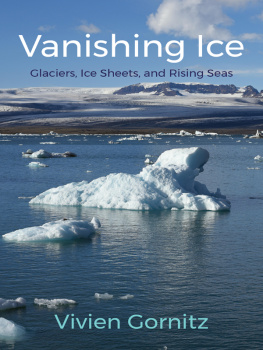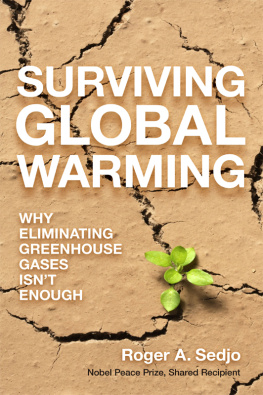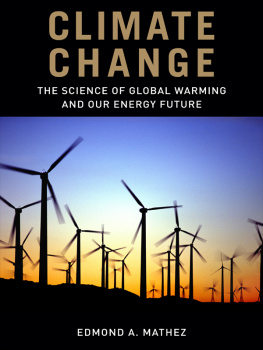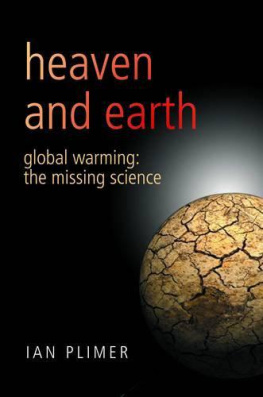R ISING SEAS
RISING SEAS
PAST, PRESENT, FUTURE
Vivien Gornitz

Columbia University Press
New York
Columbia University Press
Publishers Since 1893
New York Chichester, West Sussex
cup.columbia.edu
Copyright 2013 Columbia University Press
All rights reserved
ISBN 978-0-231-51920-5 (ebook)
Library of Congress Cataloging-in-Publication Data
Gornitz, Vivien.
Rising seas : past, present, future / Vivien Gornitz.
p. cm.
Includes bibliographical references and index.
ISBN 978-0-231-14738-5 (cloth : alk. paper) ISBN 978-0-231-14739-2 (pbk. : alk. paper) ISBN 978-0-231-51920-5 (e-book)
1. Sea levelClimatic factors. 2. Floods. 3. Climatic changes. I. Title.
GC89.G67 2012
551.458dc23
2012036495
COVER PHOTO: Marc Yankus
COVER DESIGN: Shaina Andrews
A Columbia University Press E-book.
CUP would be pleased to hear about your reading experience with this e-book at cup-ebook@columbia.edu
References to Internet Web sites (URLs) were accurate at the time of writing. Neither the author nor Columbia University Press is responsible for URLs that may have expired or changed since the manuscript was prepared.
Contents
Preface
Growing amounts of greenhouse gases in the atmosphere generated by human activities are already affecting the Earths climate, more noticeably near the poles and on high mountains. The specter of rising sea level is of growing concern to the tens of millions of people living along the worlds shorelines and on small, low-elevation islands. However, ample evidence from the geologic past indicates that the average height of the worlds oceans has varied considerably. Within the last million years alone, the Earths climate has alternated dramatically at least eight times between glaciations, when vast ice sheets blanketed northern Europe and much of North America, and interglacialswarm periods much like today. During the last glaciation, which climaxed around 21,000 years ago, the global sea level lowered by approximately 120 meters as compared with today, and during the last interglacial ~125,000 years ago, it stood 46 meters (or more) above present levels. The vast ice masses blanketing North America and Scandinavia during the last Ice Age locked up the equivalent of 120 meters (394 feet) of ocean water. After the ice melted, the sea reached nearly its present height by 7,000 to 6,000 years ago, fluctuating at most by a few feet since then.
However, the pace of sea level rise has quickened since the late nineteenth century and may be climbing even faster during the last 20 years, closely paralleling the rise in global temperature. Could future greenhouse gasinduced global warming push the Earths climate system into an unstable mode, triggering a catastrophic meltdown of the polar ice sheets? Would major coastal cities with millions of inhabitants, like New York City, Los Angeles, London, Tokyo, Shanghai, Hong Kong, Mumbai (Bombay), and Bangkok, to name just a few, be inundated?
While a major destabilization of the polar ice sheets appears unlikely within the next 100200 years, it cannot be ruled out entirely. Therefore, a certain sense of urgency motivates our need to gain a better understanding of the causes and consequences of sea level rise. Rising Seas: Past, Present, Future addresses these issues and provides the basic background for appreciating why sea level rise truly matters. The book begins with an introduction to the oceanstheir physical properties and short-term surface fluctuations due to meteorological processes, the tides, storms, and currents. The introductory chapter sets the stage for , which explores the multitude of longer-term oceanic, atmospheric, and geological processes that govern sea level over periods ranging from years to deep timei.e., tens of millions of years or more.
A much longer-term perspective, extending well beyond the 100150-year-long period of instrumental records, provides a deeper understanding of the observed twentieth-century changes and those anticipated for the near future. Bounds on past sea level variability can be set by estimating ancient sea levels from natural archives such as ocean sediments, corals, and ice cores, and running computer models. Thus, by peering into the distant past, we improve our ability to anticipate potential scenarios of sea level change and thereby plan ahead more effectively. Through an examination of the paleoclimate record, . A closer look at periods of accelerated sea level rise, such as the meltwater pulses of the last deglaciation, provides glimpses of potential worst-case scenarios of ice sheet collapse.
). Close connections exist between the greenhouse effect, evidence for a warming world, and rising sea level. Current sea level trends exceed those of past centuries. Comparison of the longer tide-gauge records with the latest satellite altimetry data suggests further recent sea level acceleration. This apparent speedup is worrisome and may portend even greater changes ahead. Some recent studies suggest that the latest Intergovernmental Panel on Climate Change (IPCC) sea level rise projections may already be too low. How much and how soon will the Greenland and Antarctic ice sheets melt? The climate system is quite sensitive to minor perturbations, and computer models may miss important signals. Given the limited ability of current global climate models to describe dynamic ice sheet behavior, which could lead to large jumps in future sea level, paleoclimate analogs could offer some important insights. (However, analogs also have drawbacks. Because past and present climatic and environmental conditions cannot be exactly replicated, these differences may preclude completely accurate future projections.)
Even today, coastal residents in low-lying areas face flood hazards from major storms. As sea level rises, the surges generated by large cyclones will reach higher and inundate more land area. Another risk is that the intensity and frequency of such extreme meteorological events could also increase in a warmer world. investigates the impacts of changing storm patterns and sea level rise on coastal regionsareas and populations at risk and examples of vulnerable cities and regions.
briefly summarizes several means of limiting carbon emissions to round out the picture. It also ties together some of the main themes of the bookfor example, the changes in sea level already under way, what the past teaches us about future outcomes, and what we can do to avert a watery future.
As this book goes to press, New York City, Long Island, and New Jersey are recovering from the devastating effects of Hurricane Sandy, which struck our shores late on October 29, 2012. This superstorm, with maximum wind gusts near 150 kilometers per hour (90 miles per hour) at landfall, 8 kilometers (5 miles) southwest of Atlantic City, NJ, caused extensive flooding in low-lying neighborhoods of lower Manhattan, Brooklyn, Queens, and Staten Island (New York City), neighboring Hoboken and Jersey City, as well as numerous seaside communities, including Atlantic City, Seaside Heights, and Point Pleasant, NJ. At the Battery tide gauge, lower Manhattan flood waters topped 13.88 feet, setting a historic record! Sandys destructiveness resulted from a rare chain of events: the collision between a tropical cyclone and a winter storm, and a blocking pattern in the jet stream that pushed the storm westward toward the New Jersey coast. Extreme flood levels in New York Harbor were caused by strong winds on the right-hand side of the hurricane that pushed water landward at high tide and full moon, and the funneling effects of the sharp bend between the New Jersey and Long Island shorelines. Since sea level in New York City has climbed 43.2 centimeters (17 inches, or 1.4 feet) since 1856, a storm of the same intensity as Sandy, had it occurred over a century ago, would have caused much less flooding and associated damage.
Next page






